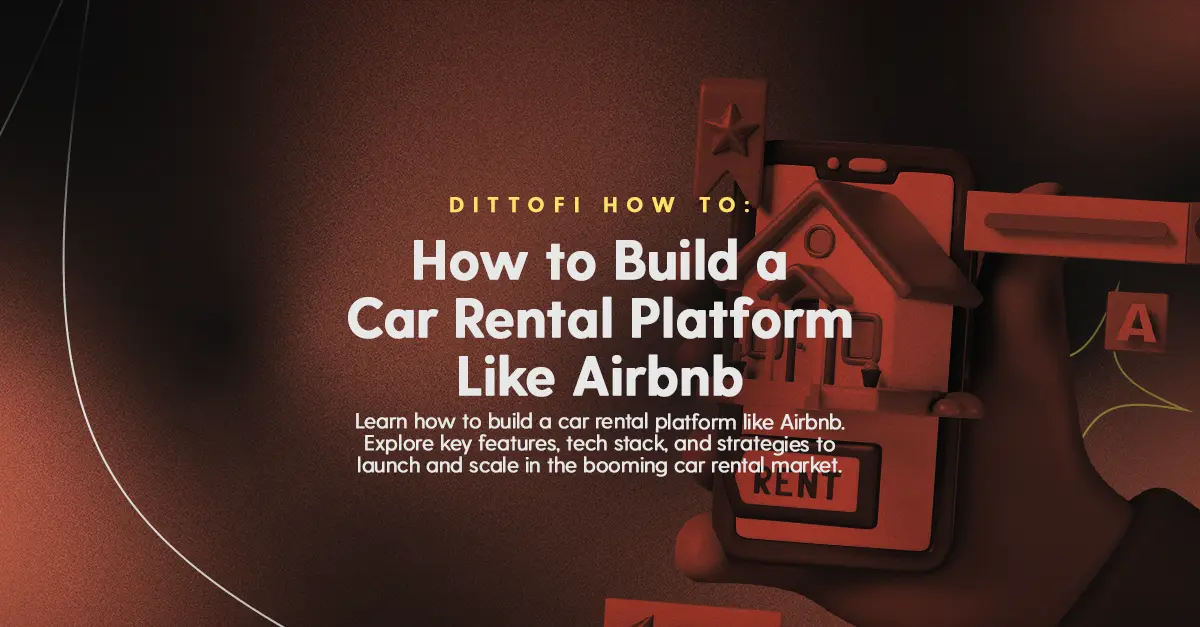Imagine having your very own car rental platform that rivals the likes of Turo, Getaround, or even Airbnb — but for cars. Sounds ambitious, right? But with the right approach, it’s 100% possible.
The peer-to-peer (P2P) car rental industry is booming. More people are opting for convenience and flexibility when renting vehicles, and platforms like Turo are cashing in on this growing demand. In fact, the global car rental market is projected to hit $145.65 billion by 2028, and peer-to-peer platforms are leading the charge.
If you’ve been thinking about building a car rental platform of your own, this guide is your ultimate roadmap. We’ll walk you through every step, from key features to development strategies, and even break down how much it will cost. Plus, we’ll share insider tips from building 150+ React-based platforms, so you’ll know exactly what works and what doesn’t.
Here’s what you’ll learn:
- How Airbnb Inspired the Rise of Car Rental Platforms
- How Airbnb Validated Their Product Idea
- How car rental platforms like Airbnb work
- Essential features for renters, car owners, and admins
- The exact steps to build your platform from scratch
- Tech stack, costs, and monetization strategies
By the end, you’ll have a complete game plan to turn your idea into a fully functioning car rental marketplace.
How Airbnb Inspired the Rise of Car Rental Platforms
When Airbnb launched in 2008, it revolutionized the sharing economy. Its approach to transforming everyday assets — spare rooms and homes — into income-generating properties inspired a wave of similar platforms, including car rental marketplaces like Turo and Getaround. These platforms applied Airbnb’s playbook to vehicles, enabling car owners to rent out their cars to travelers and locals alike.
The success of Airbnb demonstrated the immense potential of peer-to-peer (P2P) platforms. By addressing concerns around trust, payment security, and scalability, Airbnb built a global marketplace that inspired industries far beyond accommodation. Car rental platforms adapted these principles to solve unique challenges, like insurance coverage and vehicle maintenance.
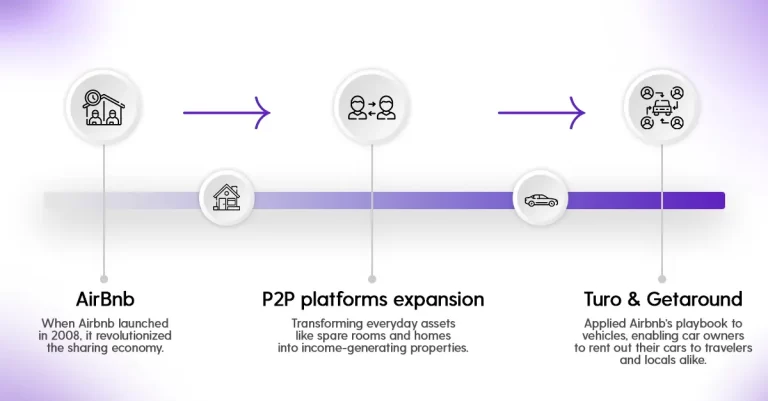
How Airbnb Validated Their Product Idea
Airbnb’s journey to becoming a household name wasn’t straightforward. Founders Brian Chesky and Joe Gebbia started by validating their idea with an MVP — a basic website offering air mattresses in their apartment during a conference in San Francisco. They manually matched hosts with guests, gathering valuable feedback to refine their concept.
Car rental platforms like Turo and Getaround followed a similar path. Instead of immediately building a complex system, they:
- Engaged with Early Adopters: Platforms connected directly with local car owners and renters to understand their needs.
- Tested Market Demand: Turo initially focused on high-demand cities, offering limited features to gauge user interest.
- Manually Facilitated Transactions: Early bookings were often handled manually to ensure a smooth experience and resolve any issues personally.
Validation doesn’t require a fully-fledged platform. Start small, test the concept, and iterate based on real-world feedback.
What is a Car Rental Platform Like Airbnb?
If you’ve ever rented a vacation home on Airbnb, you already have a basic understanding of how a car rental platform works. But instead of renting homes, you’re renting cars. These platforms connect people who need short-term car rentals with local car owners willing to rent out their vehicles.
Unlike traditional rental companies like Hertz, Budget or Enterprise, a car rental platform operates using a peer-to-peer (P2P) model. Renters can browse, book, and pay for cars directly on the platform, while car owners can list their cars, manage bookings, and earn money every time their vehicle is rented.
Here’s a simple breakdown of the process:
- Renters search for cars, filter by location, price, and type of vehicle, then book it directly through the platform.
- Car owners list their vehicles, set prices and availability, and get paid when someone rents their car.
- Admins (that’s you) manage everything from behind the scenes—user activity, payments, fees, and platform settings.
The best part? Platforms like Turo, Getaround, and Kyte don’t actually own any cars. They simply provide the platform that connects car owners with renters. This makes it a highly scalable, low-risk business model.
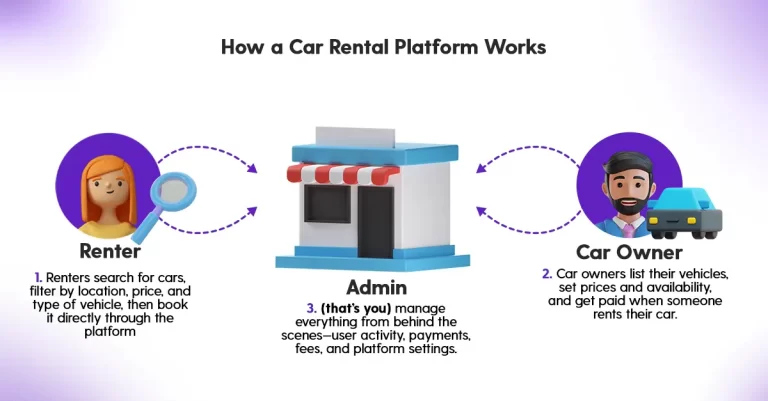
Why Build a Car Rental Platform Like Airbnb?
Why should you consider building a car rental platform? The short answer: it’s a booming market filled with opportunity. The car rental market is growing rapidly, and more people are embracing the “access over ownership” trend.
Here’s why it’s worth building your own platform:
- High Demand & Market Growth
People are shifting away from traditional car rental companies and looking for more convenient, affordable options. Platforms like Turo have capitalized on this, and you can too. In fact, P2P car rental apps are one of the fastest-growing segments of the entire car rental industry. - Recurring Revenue
Every time someone rents a car, you earn a commission. Since you don’t have to own any cars yourself, you’re building a scalable, revenue-generating business with minimal risk. - Low Overhead & Risk
Unlike traditional rental companies like Hertz, you don’t need to maintain a fleet of cars. Car owners handle the vehicles while you handle the tech platform. - Competitive Edge
By adding unique features or tapping into untapped markets (like electric vehicles or luxury cars), you can stand out from existing platforms like Turo or Getaround.
Essential Features of a Car Rental Platform
If you want to build a successful car rental platform, you’ll need to cater to three key groups of users:
- Renters: People who want to rent a car.
- Car Owners: People who list their cars for rent.
- Admins: The platform owner (that’s you) who manages everything from behind the scenes.
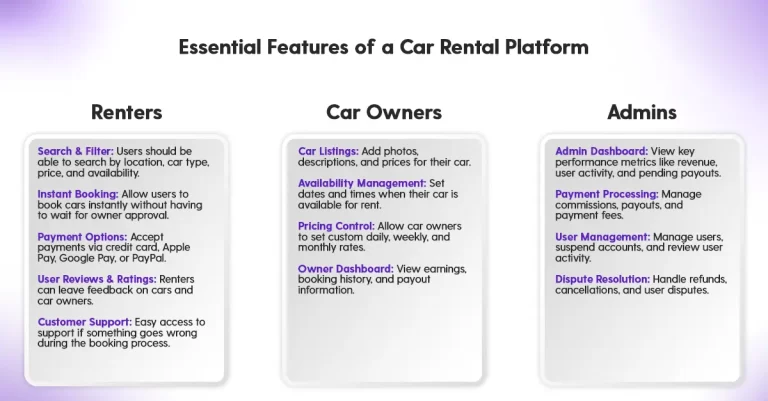
Features for Renters
To attract renters, your platform needs to be fast, simple, and easy to use. Renters should be able to search, book, and pay for cars with as few clicks as possible.
Here are the key features renters will need:
- Search & Filter: Users should be able to search by location, car type, price, and availability.
- Instant Booking: Allow users to book cars instantly without having to wait for owner approval.
- Payment Options: Accept payments via credit card, Apple Pay, Google Pay, or PayPal.
- User Reviews & Ratings: Renters can leave feedback on cars and car owners.
- Customer Support: Easy access to support if something goes wrong during the booking process.
Features for Car Owners
Car owners need the tools to manage their listings, track bookings, and get paid on time. If you make it easy for car owners to list their vehicles, more people will join your platform.
Here’s what car owners need:
- Car Listings: Add photos, descriptions, and prices for their car.
- Availability Management: Set dates and times when their car is available for rent.
- Pricing Control: Allow car owners to set custom daily, weekly, and monthly rates.
- Owner Dashboard: View earnings, booking history, and payout information.
Features for Admins (Platform Owners/You)
Admins manage the entire platform, so you’ll need tools to oversee listings, handle payments, and resolve disputes.
Here’s what you’ll need as an admin:
- Admin Dashboard: View key performance metrics like revenue, user activity, and pending payouts.
- Payment Processing: Manage commissions, payouts, and payment fees.
- User Management: Manage users, suspend accounts, and review user activity.
- Dispute Resolution: Handle refunds, cancellations, and user disputes.
By ensuring that each user group has a seamless experience, your platform will attract more renters, encourage car owners to join, and simplify day-to-day management for admins. Now that we’ve covered the must-have features for each group, let’s move on to the step-by-step process of turning your vision into a fully functional car rental platform.
How to Build a Car Rental Platform (Step-by-Step Guide)
Building a car rental platform like Airbnb requires careful planning, a solid tech stack, and an iterative approach. Here’s a step-by-step guide to help you turn your idea into reality.
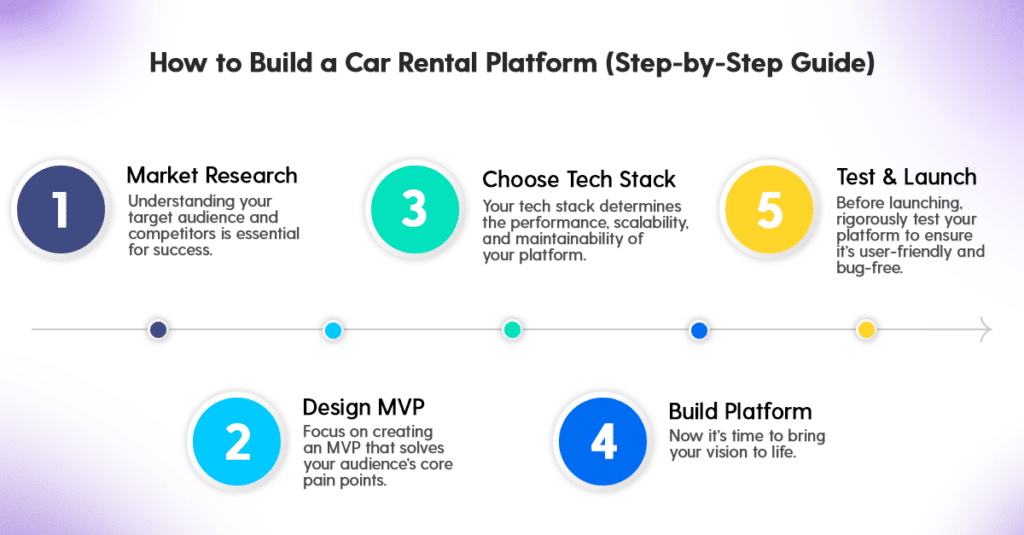
Step 1: Research Your Market
Before writing a single line of code, immerse yourself in market research. Understanding your target audience and competitors is essential for success.
- Identify Competitors: Analyze platforms like Turo, Kyte, and Getaround to understand what they offer and where they fall short.
- Example: Turo excels in user experience but lacks support for certain vehicle types like electric scooters. This could be a gap to exploit.
- Understand User Pain Points: Conduct surveys or interviews with potential renters and car owners to uncover their biggest challenges.
- Renters may want affordable rental options or quick booking processes.
- Owners might need tools to manage availability and pricing.
- Spot Market Gaps: Look for untapped niches, such as catering to specific vehicle types (electric, luxury, or classic cars) or targeting underserved locations.
- Example: Rural areas or small towns where traditional rental companies don’t operate.
Thorough market research helps you define your unique value proposition (UVP), making it easier to stand out in a crowded market.
Step 2: Design Your MVP (Minimum Viable Product)
Instead of building a fully-featured platform right away, focus on creating an MVP that solves your audience’s core pain points.
Start Small
Identify the most essential features for renters and car owners. For example:
- For Renters:
- A search and filter system by location, price, and car type.
- Instant booking functionality for seamless user experience.
- For Car Owners:
- Easy listing creation with photos, descriptions, and pricing options.
- An owner dashboard to track earnings and manage availability.
Solve One Key Problem First
Focus on delivering a solution to one major problem per user group. Renters might prioritize an effortless booking experience, while owners could need flexible scheduling tools. Once these are perfected, expand with features like advanced filters or promotional tools.
Design for Feedback
Your MVP is a starting point—not the end goal. Collect feedback from real users to refine your platform.
Example: Turo initially launched with a basic listing feature and later added insurance options and ratings based on user input.
Step 3: Choose Your Tech Stack
Your tech stack determines the performance, scalability, and maintainability of your platform. Here’s a proven stack for building a car rental platform:
- Frontend:
- Use React.js for dynamic user interfaces or Next.js for server-side rendering (SSR) to improve SEO and performance.
- Backend:
- Opt for Node.js with Express for handling API requests and server-side logic efficiently.
- Database:
- Choose PostgreSQL for relational data (e.g., user bookings and payments) or MongoDB for flexible, NoSQL data structures.
- Payments:
- Integrate with trusted payment gateways like Stripe, Braintree, or PayPal for secure transactions.
- Other Tools:
- Use AWS or Vercel for scalable cloud hosting.
- Incorporate SendGrid for transactional emails like booking confirmations.
Choosing the right stack ensures your platform can handle growth and deliver a seamless experience for all users.
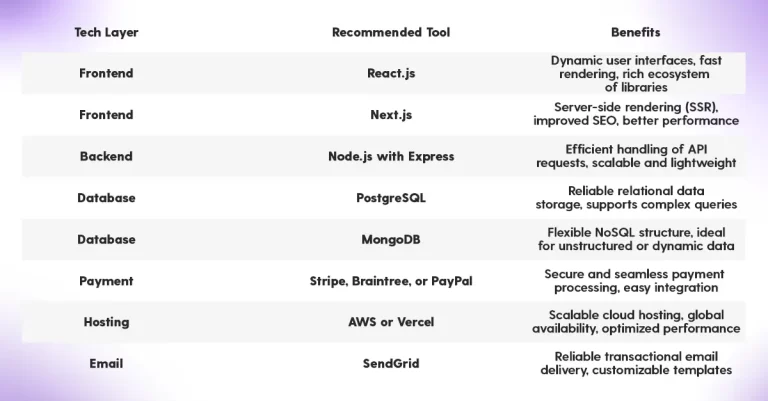
Step 4: Build Your Platform
Now it’s time to bring your vision to life.
Option 1: Hire a Development Team
If you have a budget, hire an experienced team to build your platform from scratch. They can help with customizations, scalability, and advanced features.
Option 2: Use Hybrid No-Code Tools
If you’re looking for a faster and more affordable solution, consider hybrid no-code platforms like Dittofi. These tools allow you to build a functional MVP with pre-built templates, while still giving developers control for customization later.
Development Tips:
- Start with the backend: Build APIs for critical features like user authentication, car listing management, and booking flows.
- Focus on the frontend after core functionalities are ready.
- Use modular development: Create reusable components (e.g., booking forms, search filters) to speed up future updates.
Step 5: Test & Launch
Before launching, rigorously test your platform to ensure it’s user-friendly and bug-free.
Testing Checklist:
- Usability: Conduct user testing sessions to ensure the booking and listing processes are intuitive.
- Performance: Use tools like Google Lighthouse or GTmetrix to check page load times and optimize Core Web Vitals.
- Cross-Browser Compatibility: Test on Chrome, Safari, Edge, and Firefox to ensure consistency.
- Scalability: Simulate high-traffic scenarios to ensure your platform can handle growth.
Launch Strategy:
- Begin with a soft launch in one city or region. Focus on areas with high car rental demand and limited competition.
- Use early adopters to gather feedback and address pain points.
- Once you’ve fine-tuned your MVP, scale to additional cities or regions.
Building a car rental platform is a marathon, not a sprint. By following this step-by-step guide, you’ll create a scalable, user-focused platform that meets market demands and evolves based on user feedback. Up next, we’ll explore how to optimize monetization strategies and scale your platform for long-term growth.
How Much Does it Cost to Build a Car Rental Platform?
Building a car rental platform isn’t cheap, but it’s more affordable than you might think.
Here’s a rough estimate of costs:
- Custom Development: $50K to $200K (for fully custom development)
- No-Code Development: $10K to $50K (faster, cheaper, but less control)
- Monthly Cloud Hosting: $500 to $2,000 per month
If you want to save money, consider using hybrid no-code platforms to build an MVP. You can always upgrade to custom development as your platform grows.
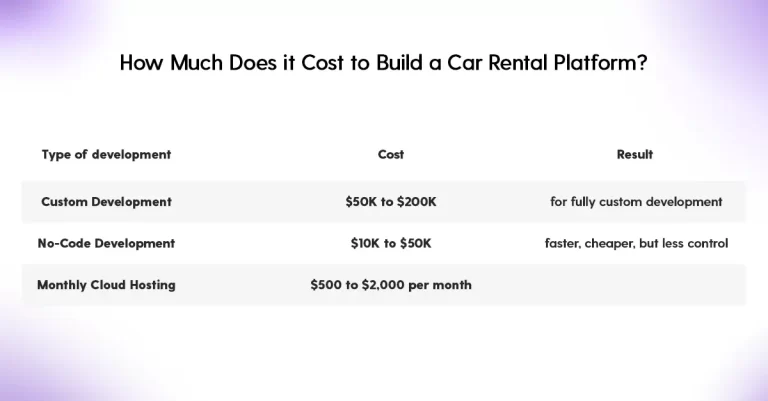
How Do Car Rental Platforms Make Money?
Car rental platforms like Turo and Getaround have mastered the art of monetization through a variety of revenue streams. By diversifying how they generate income, these platforms ensure sustainable growth while delivering value to both renters and car owners.
Here are some of the most common ways these platforms make money:
- Commissions: Taking a percentage of each booking, similar to how Airbnb operates. This ensures a steady flow of income with every transaction.
- Listing Fees: Charging car owners to list their vehicles on the platform. This fee incentivizes owners to provide high-quality listings.
- Insurance Fees: Offering optional insurance packages for renters, which adds a layer of security for both parties while generating additional revenue.
Understanding these monetization strategies is crucial if you want your platform to thrive.
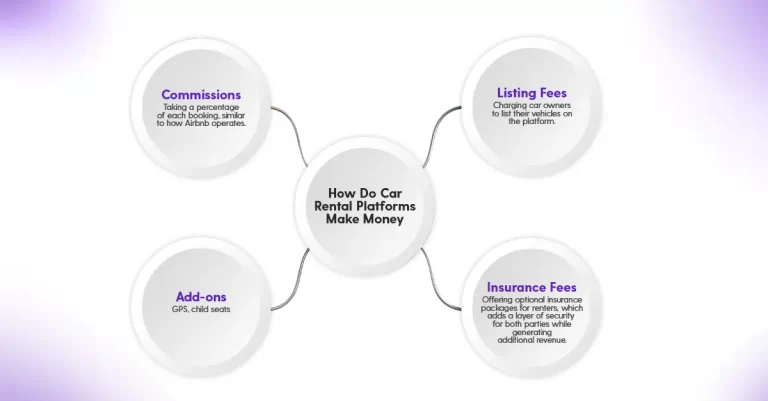
Conclusion: Build Your Own Car Rental Platform Like Airbnb
If you’re ready to create a platform that connects renters with car owners, now’s the perfect time to get started. With the rise of peer-to-peer car rentals, you can build a highly scalable, profitable business in a fast-growing market.
By following the steps in this guide, you’ll have everything you need to launch a successful platform. Whether you hire developers or use a no-code platform, your car rental business can be up and running in months.
Ready to build your own car rental platform? Let’s do it!
Build Your Own Marketplace!
Ready to turn your vision into reality? Start your journey with the right tools, expert guidance, and a proven roadmap to success!

